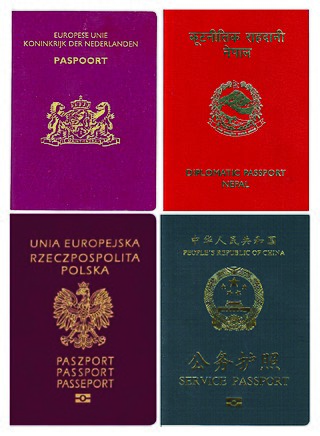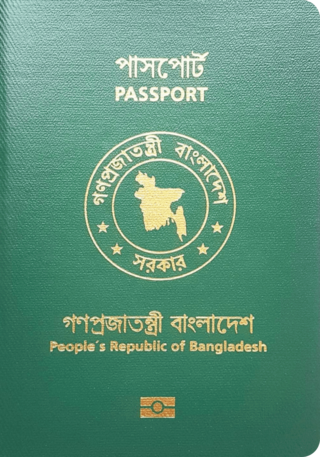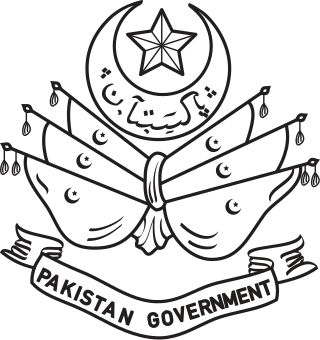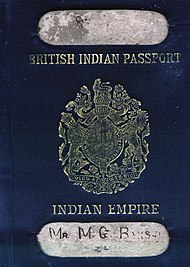
A passport is an official travel document issued by a government that contains a person's identity. A person with a passport can travel to and from foreign countries more easily and access consular assistance. A passport certifies the personal identity and nationality of its holder. It is typical for passports to contain the full name, photograph, place and date of birth, signature, and the expiration date of the passport. While passports are typically issued by national governments, certain subnational governments are authorised to issue passports to citizens residing within their borders.

Indian nationality law details the conditions by which a person holds Indian nationality. The two primary pieces of legislation governing these requirements are the Constitution of India and the Citizenship Act, 1955.

The Hong Kong Special Administrative Region of the People's Republic of China passport is a passport issued only to permanent residents of Hong Kong who also hold Chinese citizenship. In accordance with the Basic Law of the Hong Kong Special Administrative Region, since the transfer of sovereignty on 1 July 1997, the passport has been issued by the Immigration Department of the Government of Hong Kong under the authorisation of the Central People's Government of the People's Republic of China. As the official languages of Hong Kong are Chinese and English, the passport is printed bilingually in both Chinese and English.

The primary law governing nationality of the Republic of Ireland is the Irish Nationality and Citizenship Act, 1956, which came into force on 17 July 1956. Ireland is a member state of the European Union (EU) and all Irish nationals are EU citizens. They enjoy free movement rights in EU and European Free Trade Association (EFTA) countries and may vote in elections to the European Parliament.

A British passport is a travel document issued by the United Kingdom or other British dependencies and territories to individuals holding any form of British nationality. It grants the bearer international passage in accordance with visa requirements and serves as proof of citizenship. It also facilitates access to consular assistance from British embassies around the world. Passports are issued using royal prerogative, which is exercised by His Majesty's Government; this means that the grant of a passport is a privilege, not a right, and may be withdrawn in some circumstances. British citizen passports have been issued in the UK by His Majesty's Passport Office, an agency of the Home Office, since 2014. All passports issued in the UK since 2006 have been biometric.

Australian passports are travel documents issued to Australian citizens under the Australian Passports Act 2005 by the Australian Passport Office of the Department of Foreign Affairs and Trade (DFAT), both in Australia and overseas, which enable the passport bearer to travel internationally. Australian citizens are allowed to hold passports from other countries. Since 1988 over a million Australian passports have been issued annually, and it reached 1.4 million in 2007, and increasing towards a projected 3 million annually by 2021. As of 29 March 2023, Australian citizens had visa-free or visa on arrival access to 187 countries and territories, ranking the Australian passport seventh in the world in terms of travel freedom according to the Henley Passport Index.

An Indian passport is a passport issued by the Ministry of External Affairs of the Republic of India to Indian citizens for the purpose of international travel. It enables the bearer to travel internationally and serves as proof of Indian citizenship as per the Passports Act (1967). The Passport Seva unit of the Consular, Passport & Visa (CPV) Division of the Ministry of External Affairs functions as the issuing authority and is responsible for issuing Indian passports on application to all eligible Indian citizens. Indian passports are issued at 93 passport offices located across India and at 197 Indian diplomatic missions abroad.

A South African passport is a travel document issued to citizens of South Africa for the purpose of international travel. It allows the bearer to travel in foreign countries in accordance with visa requirements, and facilitates the process of securing assistance from South African consular officials abroad, if necessary. A South African passport is a valid proof of citizenship document according to South African nationality law. As of 2018, citizens of South Africa enjoyed visa-free access to 100 countries, of which some may require pre-travel registration according to the Visa Restrictions Index.

A travel document is an identity document issued by a government or international entity pursuant to international agreements to enable individuals to clear border control measures. Travel documents usually assure other governments that the bearer may return to the issuing country, and are often issued in booklet form to allow other governments to place visas as well as entry and exit stamps into them.

The Singaporean passport is a travel document and passport issued to citizens and nationals of the Republic of Singapore. It enables the bearer to exit and re-enter Singapore freely; travel to and from other countries in accordance with visa requirements; facilitates the process of securing assistance from Singaporean consular officials abroad, if necessary; and requests protection for the bearer while abroad.

The Brazilian passport is the official document for foreign travel issued by the federal government, through the Federal Police.

North Macedonian passports are issued to citizens of North Macedonia for the purpose of international travel. Responsibility for their issuance lies with the Ministry of the Interior. The validity of the passport is 5 years for persons 4 to 27 years of age and 10 years for those 27 years of age and older. For children ages four and under, the validity of the passport is limited to two years. The passports conform to the recommended standards of the International Civil Aviation Organization (ICAO), and are biometric passports.

Iranian passports are issued to nationals of Iran for the purpose of international travel. The passport serves as a proof of Iranian citizenship. The Iranian passports are burgundy, with the Iranian emblem emblazoned on the top of the front cover.

The passport of Bangladesh is an ICAO compliant, machine-readable and biometric e-passport issued for the purpose of travel to foreign countries by the passport holder. Bangladesh is the first country in South Asia to issue e-passports for all eligible citizens. The passport booklet is manufactured, printed and issued by the Department of Immigration & Passports of the Ministry of Home Affairs. This electronic microprocessor chip embedded e-passport has forty-one different security features, including holographic images embossed in thin-film laminate, which change colour under light and appear to move. Demographic and biometric information of the e-passport holder are stored on the chip inside the e-passport. This information includes the fingerprints of all ten fingers of the passport holder; the iris scan of both eyes; a color photograph of the face of the bearer; their digital signature; etc. Depending on the age of the applicant, the e-passport is valid for either five years or ten years and it is distributed by the Government of The People's Republic of Bangladesh, or by any of its overseas diplomatic missions, to eligible Bangladeshi nationals who are citizens by birth, by descent or through naturalization.

The primary law governing nationality in the United Kingdom is the British Nationality Act 1981, which came into force on 1 January 1983. Regulations apply to the British Islands, which include the UK itself and the Crown dependencies, and the 14 British Overseas Territories.

Pakistani nationality law details the conditions by which a person holds Pakistani nationality. The primary law governing nationality regulations is the Pakistan Citizenship Act, 1951, which came into force on 13 April 1951. With few exceptions, almost all individuals born in the country are automatically citizens at birth. Foreign nationals may naturalise as Pakistani citizens after residing in the country for at least five years and showing proficiency in at least one vernacular language of Pakistan.
The nationality law of Bangladesh governs the issues of citizenship and nationality of the People's Republic of Bangladesh. The law regulates the nationality and citizenship status of all people who live in Bangladesh as well as all people who are of Bangladeshi descent. It allows the children of expatriates, foreigners as well as residents in Bangladesh to examine their citizenship status and if necessary, apply for and obtain citizenship of Bangladesh.

The passport of Kosovo is a travel document that is issued to the citizens of Kosovo.The document facilitates international travel as well as serving as proof of citizenship. The issuance of passports is the prerogative of the Ministry of Internal Affairs, with the exception of diplomatic passports which are issued by the Ministry of Foreign Affairs. Kosovar passports comply with all the recommended standards set for machine-readable passports by the International Civil Aviation Organization (ICAO), but the country/citizenship code RKS is not within ISO 3166 and thus not ICAO-endorsed. The passport design was disclosed on 14 March 2008.

Overseas Citizenship of India (OCI) is a form of permanent residency available to people of Indian origin and their spouses which allows them to live and work in India indefinitely. Despite its name, OCI status is not citizenship and does not grant the right to vote in Indian elections or hold public office. The Indian government can revoke OCI status in a wide variety of circumstances. In addition, the OCI card is only valid with a valid foreign passport. As of 2020, there are 6 million holders of OCI cards among the Indian Overseas diaspora.

Fijian nationality law details the conditions by which a person is a national of Fiji. The primary law governing nationality requirements is the Citizenship of Fiji Act 2009, which came into force on 10 April 2009.
























